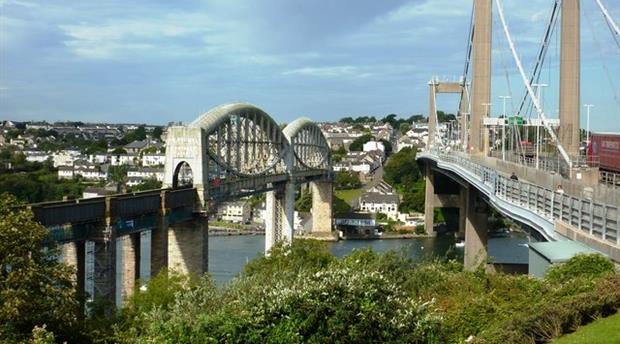This site uses cookies. By continuing to browse the site you are agreeing to our use of cookies. Read our privacy policy.
The River Tamar: Cornerstone of Devon’s Past, Present, and Future

App for Devon: Article of Interest
The River Tamar: Cornerstone of Devon’s Past, Present, and Future
Written by Emily Stewart
Last Edited 8 January 2015
Devon is one of the United Kingdom’s most recognized scenic locations: its 250 miles of north and south coastline, rural scenic routes (Devon has more thatched cottages than anywhere else in Great Britain), sunny skies, and windswept Dartmoor hills attract artists and travellers alike. Flora and fauna are fed by Devon’s major river routes: the Avon, the Axe, the Dart, the Erme, the Exe, the Otte; the Sid; the Tamar, the Tavy; the Taw and Torridge, the Teign and the Yealm (details taken from The Little Book of Devon by Emma Mansfield). In particular, the Tamar River is a seminal descriptor of Devon’s past, present, and future. Used by centuries of Devonians as an economic thoroughfare, the Tamar now stands as sometimes controversial natural resource for artists, military organizations, and visitors.
One such art and community project covering topics related to the Tamar is the River Tamar Project, a public programme that commissions creative practitioners who occupy the space between art, architecture, design, science and technology. The organization works with the communities along the banks of the Tamar to further explore its human use through activities that explore the cultural context of the river. In this piece, App for Devon provides a brief description of the Tamar’s past, present, and future, supplemented by fun facts from the Little Book of Devon (by Emma Mansfield) and examples from the modern activities pursued by the River Tamar Project.
Past
According to the Little Book of Devon, “The River Tamar separates Devon and Cornwall and was an important route for the mineral industry of Berel Alston and Morewellham. Over 1,000 years ago, Morewellham Quay was an important port for the shipping of locally mined tin, silver, granite and copper.” The Tamar has supported various civilizations in Devon throughout the years, powering industry, agriculture, and commerce. In more recent years the military heavily utilized the river for vessel storage and refurbishment. Many Plymothians over the age of 30 remember seeing warships stored in the safety of the Tamar Estuary.
Not only has the River Tamar provided a practical backdrop to legions of developments, but the river historically incited artistic creations. As the Tamar Project website states, “artists, musicians, and writers have responded to the context of the River Tamar and have been part of its energy for centuries and, like all places, the resulting artworks became a record of its history.” JMW Turner was a British landscape artists renowned for his illustrations of the Industrial Revolution on the banks of the Tamar. Of course, infamous portraits place Napolean, Sir Francis Drake, and other notables on the river. Like the prehistoric rock drawings depicting Dartmoor vistas, antiquated images of the River Tamar invoke the admiration of Devon’s generations.
Present
The Tamar River today still serves as a major route for economic activity. In her Little Book of Devon, Emma Mansfield exemplifies how the Royal Albert Bridge as an important piece of Devon transit: “Running for 677 metres, 52 metres above the River Tamar, Brunel’s Royal Albert Bridge is one of the most famous railway bridges in Britain.” Another bridge is the Tamar Bridge, which opened in 1961. According to Ms. Mansfield, “Today it transports 16 million vehicles a year making it the fifth-busiest river crossing Great Britain.”
The thriving Tamar Valley Tourism Association and Tamar Valley Centre in Gunnislake demonstrate the impact of the river on Devon’s tourism economy. The Little Book of Devon details tourism as being responsible for 24% of industry in Devon. One only needs peruse the App for Devon to find listings of activities, events, B&B’s and restaurants lining the Tamar’s banks to know the river holds a place among more publicized Devon visitation points.
Recognizing that support of the Tamar encourages a robust economic scene in Devon, the River Tamar Project seeks to create a dialogue between entities like communities, tourist organizations, and the military. In the wake of heavy federal deficits beginning in the 1980’s, the River Tamar has been largely decommissioned for military use, opening it up as an interesting space for exploring art and innovation. Every two years the River Tamar Project presents its newest exhibition about the changing nature of the waterway. In September of 2014 it hosted the, “It’s all about the River” film festival, inviting international and local artists to craft pieces about the waterway. Films showed in locations across Devon like the independent Exeter Phoenix theatre. One of the films was employed by a Barne Barton housing estate. The estate was seeking greater access to the river from current military holding. In partnership with the Southwest Film Association, the River Tamar Project helped to fund and support Barne Barton’s pitch. The River Tamar Project itself is supported by the Peninsula Arts Program of the University of Plymouth. This unification of stakeholders for, on, and around the River Tamar foreshadows exciting possibilities.
Future
It is unclear the effect of changing weather conditions on the salmon population, soft fruit growers, and market gardens sheltered by the River Tamar. With less military intervention, the Tamar is likely to see increased tourism activities and local access. Needless to say, the waterway will continue to influence and be influenced by the larger Devon environment.
As for the River Tamar Project staff are curating a series of large scale art commissions in 2016/ 17. New commissions will be situated on the riverbanks and within its waters. In the longer-term, the River Tamar Project endeavours to create a floating solar-powered classroom. The room will act as an education resource for the region, allowing children, students, and local residents to learn and explore from a moveable base on the river itself. A riverside culture centre will support the classroom to explore the history of the river and its influence, address the environmental changes, and create new human use.
In her conclusion, Emma Mansfield humbly summarizes the creative resourcefulness of Devonians in their natural environment: “I’m always inspired by the quirky creations and stores that have been born from necessity: she really is the mother of invention. The rural challenges Devon, Cornwall and many southwest counties have faced over the years have crested all kinds of historical events, both old and new, as well as new businesses, action groups and opportunities for people.” The past, present, and future of the River Tamar is a merely a snippet of the innovative, grass-roots, and unique ambience in this appealing British county.
For more information on the River Tamar Project, please visit http://tamarproject.org.uk/
For more information on The Little Book of Devon, please visit http://www.thelittlebooksof.com/
